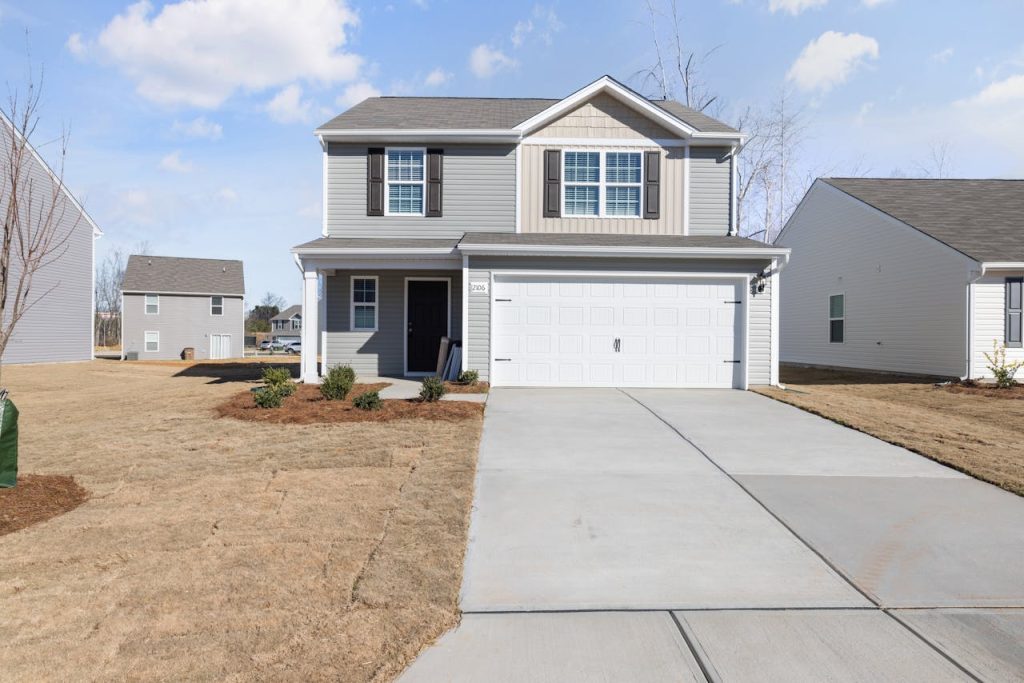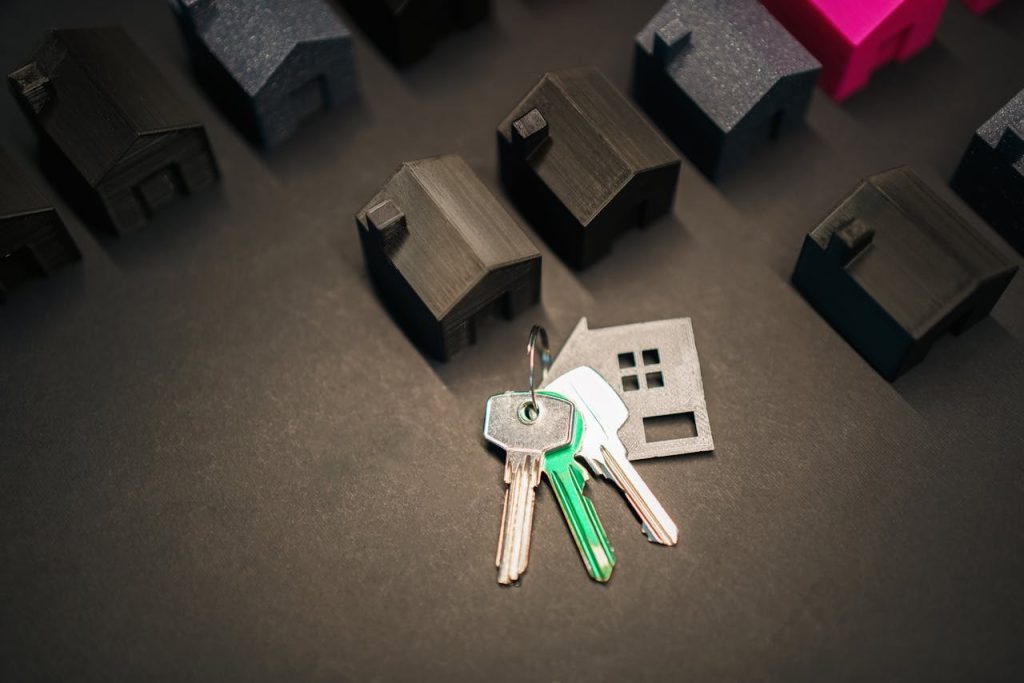Let’s break it down. We’ll look at why these homes are hard to sell. We’ll also cover practical steps you can take to tackle the issue. If you want a quick and easy option, consider a cash sale through Doctor Homes.
What is a Split-Level Home?
A split-level house has a staggered floor plan. You enter on the main level, which usually houses the kitchen and living area. Just a few steps up, and you’ll find the bedrooms tucked away on the upper level. Another half flight goes down to the basement or den. This layered design provides a smart way to use space on small suburban lots.
These homes were all the rage during the mid-century suburban boom. In the past, families appreciated having separate areas for living and sleeping. Today, though, those staggered layouts can feel more like a maze than a modern retreat.
Can’t sell your split-level? We will. Get a fast cash offer today!
Bi-Level vs. Split-Level Home
Bi-level and split-level homes seem alike at first. They’re like cousins, albeit with different personalities. Knowing the difference can help you sell your property. It can also help you figure out how much effort is needed to attract the right buyer.
- Bi-Level (also called Raised Ranch)
You walk into a landing and immediately choose up or down. The upper level usually has the kitchen, living room, and bedrooms. The lower level often includes extra living space, a laundry area, or a garage. It’s a simpler two-level setup.
- Split-Level
Think more staircases and more segmentation. You usually enter on a middle floor, with stairs going both up and down. The top level has bedrooms. The mid-level features the kitchen and living room. The lower level might include a den or a second living area. In some homes, there’s even a fourth level with a basement.
Both styles came about during the mid-century suburban boom. They made efficient use of space on smaller lots. But over time, changing tastes have created a gap in buyer demand.
Which Layout Fares Better in Today’s Real Estate Market?
Bi-levels generally have the edge in marketability. Why?
- • Fewer stairs. Buyers like one long staircase better than many short ones.
- • Simpler to modernize. Bi-levels usually have fewer walls and a more open layout. This makes it easy to update them to fit today’s design trends.
- • Better flow. A split-level home doesn't look as nice as a bi-level home.
Why Split-Level Homes Are Harder to Sell
Split-level homes face special challenges in today’s market. Their layouts may feel outdated, and they often lack curb appeal. Also, accessibility can be a concern. These things can make buyers unsure and lose interest.
- Curb Appeal Challenges
Let’s be honest—first impressions matter. These homes often don’t have the curb appeal that buyers want today. The offset garage, awkward rooflines, and chopped-up entryways make it harder to charm from the street.
Quick Fix Tip: Fresh landscaping, a bold front door, updated lighting, and modern siding can work wonders. Improving curb appeal is a small investment that pays off. This is key for drawing more attention, both online and offline.
- Tri-Level House Disadvantages
The chopped-up floor plan might have been trendy in 1965, but today it’s a harder sell. Buyers prefer clean, open spaces that flow. Mini-levels and rooms on different floors may feel cramped or cut off.
It also makes staging more complicated. Highlight the function in each zone. This can be tough without a designer's skill or some renovation magic.
- Stairs and Home Accessibility
Stairs, stairs, and more stairs. That’s one of the biggest sticking points. This setup isn’t for everyone. It’s hard for seniors, those with mobility issues, and families with young kids.
Buyers looking for long-term homes may see those stairs as future obstacles. And let’s face it, the idea of schlepping laundry up and down two or three levels is no one’s dream scenario.
- Natural Light in Split-Level Homes
The segmented layout can limit natural light. Rooms tucked in corners or partly below ground can leave you turning on lights at noon.
Lighting Upgrade Tip: Replace dark curtains with sheer panels. Add mirrors to reflect light. Invest in LED lighting to brighten the space and give it a modern feel.
- Selling an Outdated Home
These properties still rock the wood paneling and wall-to-wall carpet. You'll also find popcorn ceilings and the old avocado-green appliances. You get the picture.
Today’s buyers want fresh and move-in-ready. When they enter a home that seems like a retro time capsule, they either leave or cut their offer a lot.
Outdated layout? No problem. Sell your split-level home as-is, now.
Improving Split-Level Home Value Before Selling
Boosting your home’s value before you sell can ease buyer worries. It can also help speed up the selling process. With the right updates, an old layout can feel new and ready to sell.
Split-Level Home Renovation Ideas
- • Open up the space between the kitchen and living room to create a more modern, airy vibe.
- • Enhance your home's exterior with stone façades, new paint, or chic trim.
- • Refresh your space with hardwood floors. Add recessed lights and use neutral colors.
But renovations take time—and money. And if you’re facing financial pressure, a fast-track sale might be the better route.
Best Upgrades for Resale
- • Kitchen and bath upgrades are always winners. Sleek countertops and modern fixtures go a long way.
- • Smart home tech can draw in younger buyers. This includes thermostats, security systems, and doorbells.
- • Upgrade to energy-efficient features like new windows, insulation, and HVAC systems. These upgrades appeal to buyers and investors. They focus on long-term savings and lower utility costs.
Still feeling overwhelmed? Doctor Homes buys properties as-is. This means you can skip updates and still get cash in hand.
Marketing Split-Level Homes
In marketing, a great first impression can change “just browsing” to “let’s schedule a showing.” Split-level homes can be hard to sell. But with the right approach, they can shine in a busy real estate market.
Creating a Compelling Listing Description
Now’s your chance to change the game. Show what makes the home functional, flexible, and full of potential. Focus on benefits over features. For example:
Instead of:
"Three levels with separate living areas."
Say:
"Ideal for families or roommates. This home offers privacy, versatility, and room to spread out."
Highlight lifestyle perks, such as a dedicated office space, areas for teens to hang out, or options for multigenerational living.
Professional Photos and Virtual Walkthroughs
Photos matter. A lot. Visuals are key, especially with unusual layouts. They help buyers see how the home flows and functions, even before they visit. Invest in:
- • Wide-angle shots show how each level connects.
- • Twilight exterior photos enhance curb appeal.
- • 3D walkthroughs and video tours clearly show the layout to viewers. They help remove confusion.
Bonus: These visuals can help your listing stand out on Zillow and Redfin.
Targeting the Right Audience
Not every buyer will fall in love with a multi-level layout—and that’s okay. Focus your marketing on people who see the value:
- • First-time buyers: Often more flexible and budget-conscious.
- • Cash home buyers and investors: Looking for properties with strong investment potential or good rental options.
- • Multigenerational families: People who need separate living spaces for grandparents, in-laws, or adult children.
Ready to Sell? Doctor Homes Makes It Easy.
If you’re in San Francisco, Kansas City, Saint Louis, Cleveland, Detroit, or Indianapolis, choose Doctor Homes. They make selling easy and hassle-free. If you have an inherited property, face financial trouble, or need a quick fix, we can help. Our team provides fair cash offers. There are no hidden fees, no repairs, and no stress.
- • No commissions
- • No showings
- • Close in as little as seven days.
Get a free, no-obligation cash offer today.
Final Thoughts: Selling Smart in Today’s Market
So, why are split-level homes harder to sell? It’s a mix of old layouts, curb appeal issues, and access problems. These homes were once popular in the suburbs, but today’s buyers expect more.
That doesn’t mean you’re stuck. Doctor Homes provides a quick and fair solution. We can help you with life changes, repairs, or if you need to sell your property quickly.
FAQs about Selling a Split-Level Home
How does a bi-level home differ from a split-level design?
A bi-level has two stacked floors. A main staircase separates the two. A split-level often has three or more staggered levels. This design creates more separate spaces. The split-level layout can seem disjointed. This makes modernizing it tougher.
Why do split-level homes have less curb appeal?
The staggered design, front-facing garages, and uneven roofs make it look cluttered. Small updates, like new landscaping and modern finishes, can boost buyer interest.
Are split-level homes difficult to sell because of stairs?
Yes. Stairs can be a deal breaker. Older buyers, families with young kids, and people with disabilities often struggle with them. The layout needs a lot of moving up and down between levels. This isn't great for everyone.
Which upgrades offer the most value when updating a split-level property?
Focus on kitchens, bathrooms, and lighting. Take down walls when you can to make a more open living area. Energy-efficient windows, new HVAC systems, and modern flooring offer solid returns.
What are the main benefits of selling a split-level home to cash home buyers?
Speed, convenience, and peace of mind. You don’t have to make repairs, stage the house, or wait for financing approvals. Cash buyers like Doctor Homes buy properties as-is. They often close deals in just a few days.




